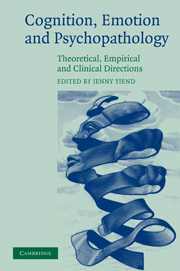Book contents
- Frontmatter
- Contents
- List of contributors
- An introduction and synthesis
- Andrew Mathews: a brief history of a clinical scientist
- Part I Theoretical approaches
- Part II Empirical directions
- 5 Habits of thought produce memory biases in anxiety and depression
- 6 Anxiety and the resolution of ambiguity
- 7 Dissociating fear and disgust: implications for the structure of emotions
- 8 The causal status of anxiety-linked attentional and interpretive bias
- 9 The experimental modification of processing biases
- Part III Clinical perspectives
- Index
6 - Anxiety and the resolution of ambiguity
Published online by Cambridge University Press: 23 November 2009
- Frontmatter
- Contents
- List of contributors
- An introduction and synthesis
- Andrew Mathews: a brief history of a clinical scientist
- Part I Theoretical approaches
- Part II Empirical directions
- 5 Habits of thought produce memory biases in anxiety and depression
- 6 Anxiety and the resolution of ambiguity
- 7 Dissociating fear and disgust: implications for the structure of emotions
- 8 The causal status of anxiety-linked attentional and interpretive bias
- 9 The experimental modification of processing biases
- Part III Clinical perspectives
- Index
Summary
Any complete explanation of human cognition must address the issue of ambiguity resolution. We are constantly confronted by indeterminate stimuli that need to be resolved in order for the cognitive system to function in an efficient and adaptive way. There is copious literature on the resolution of ambiguity in text comprehension, and abundant research on interpersonal processes and deciphering of ambiguous signals. The role of depression and dysphoria in ambiguity resolution has also been examined (e.g. Cane & Gotlib, 1985; Lawson & MacLeod, 1999), but the focus of the present chapter is on the influence of anxiety and anxiety related disorders on ambiguity resolution. In evolutionary terms, anxiety functions to alert the system to impending danger (e.g. Eysenck, this volume, 1992, 1997; LeDoux, 1996; Öhman, 1996), and this involves correctly interpreting ambiguous signals that could predict harm. There is evidence that an evolved neural substrate may be involved in the recognition of fear and danger, and that the amygdala plays a crucial role (e.g. Adolphs, Tranel, Damasio & Damasio, 1995; Calder, Young, Rowland, Perrett, Hodges & Etcoff, 1996; see also Lawrence, Murphy & Calder, this volume). However, Whalen (1998) proposes that the amygdala is maximally responsive to ambiguous information.
Experiments with verbal stimuli
Early studies into the resolution of ambiguity relied on self-report methodology. Seminal work by Andrew Mathews and colleagues (Butler & Mathews, 1983, 1987) demonstrated that anxious individuals rated negative outcomes of ambiguous scenarios as being subjectively more likely to happen and more costly than did the controls. Similar effects have been observed for depressed (Butler & Mathews, 1983) and socially phobic individuals (Amir, Foa & Coles, 1998; Stopa & Clark, 2000).
- Type
- Chapter
- Information
- Cognition, Emotion and PsychopathologyTheoretical, Empirical and Clinical Directions, pp. 130 - 148Publisher: Cambridge University PressPrint publication year: 2004
- 12
- Cited by



